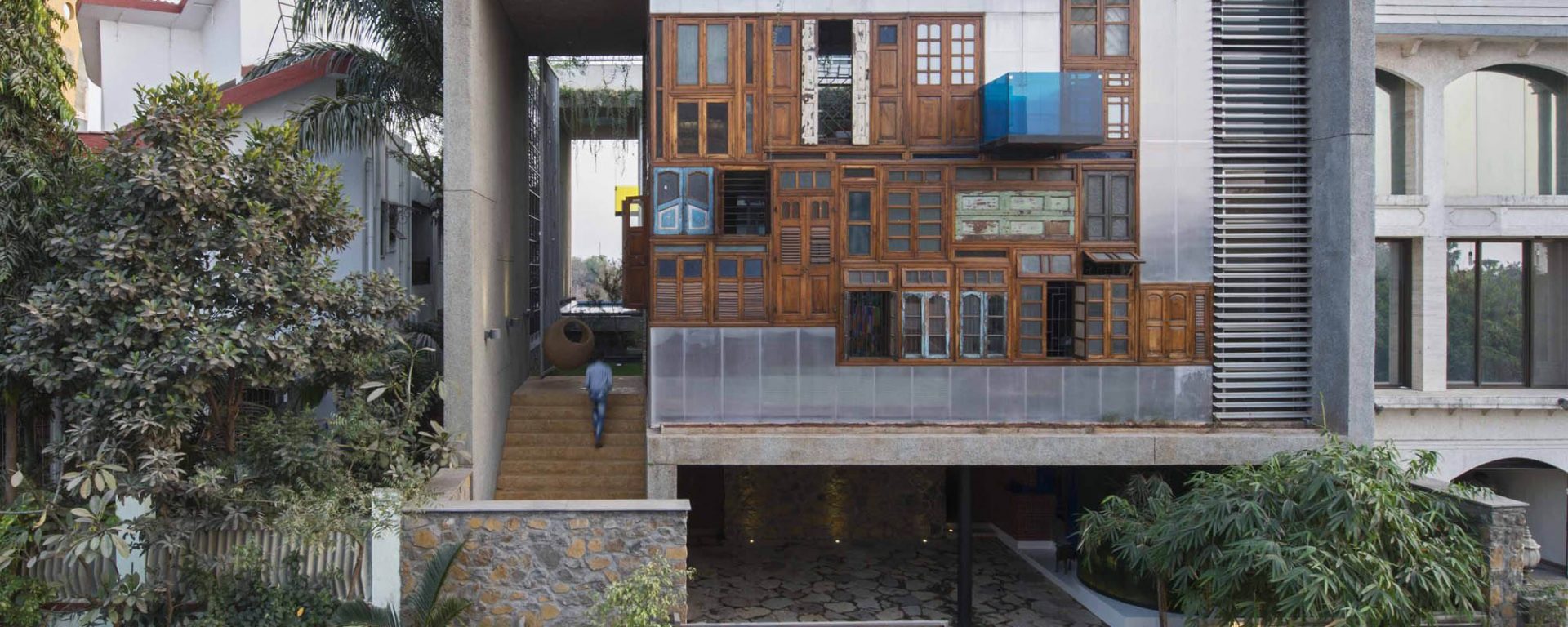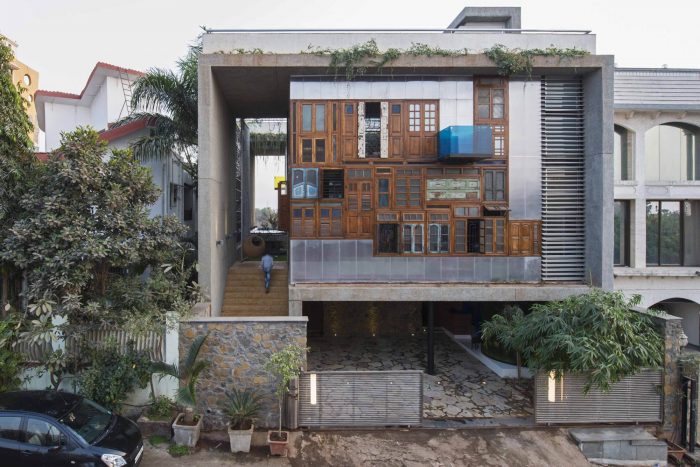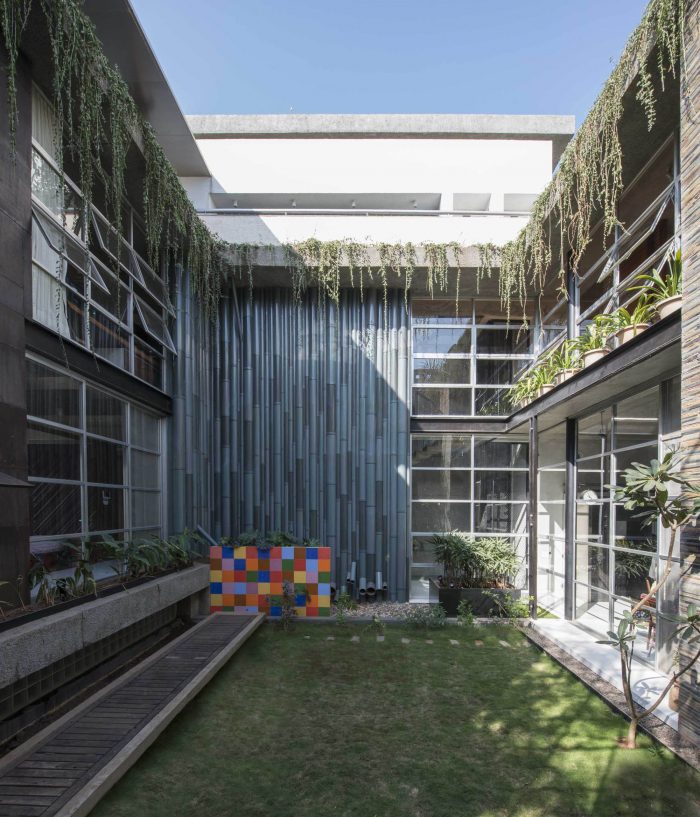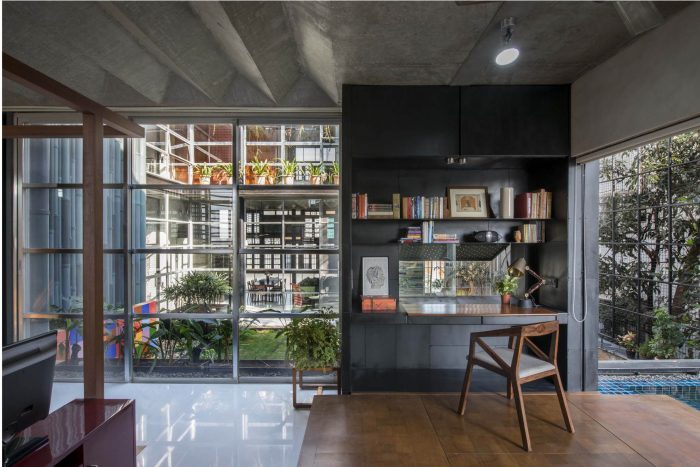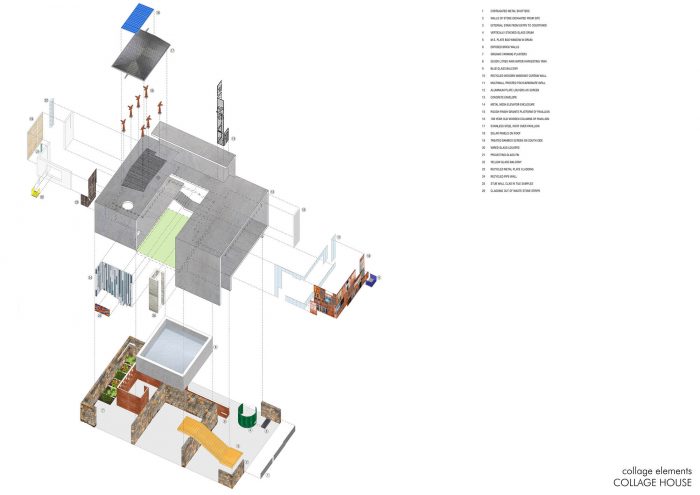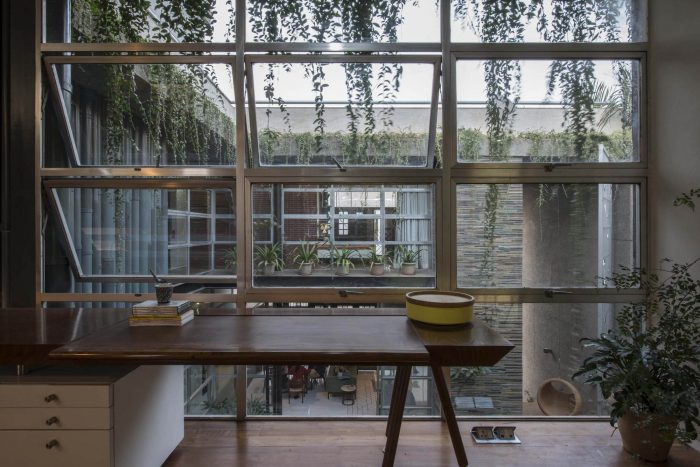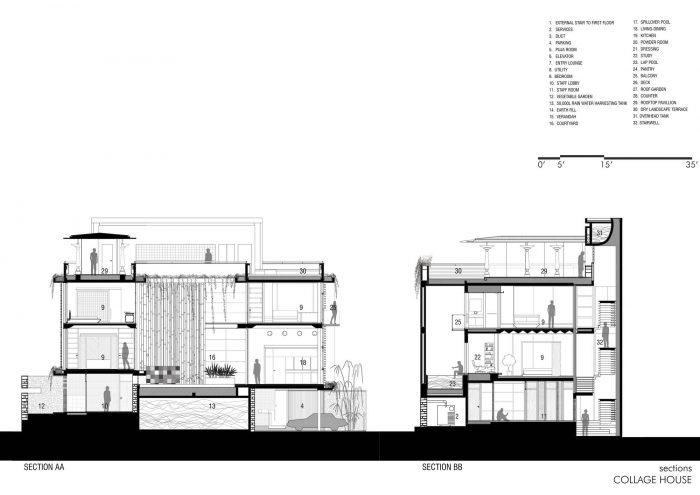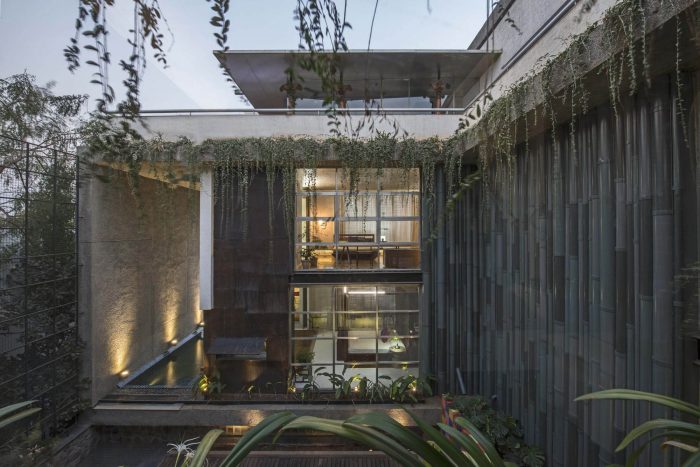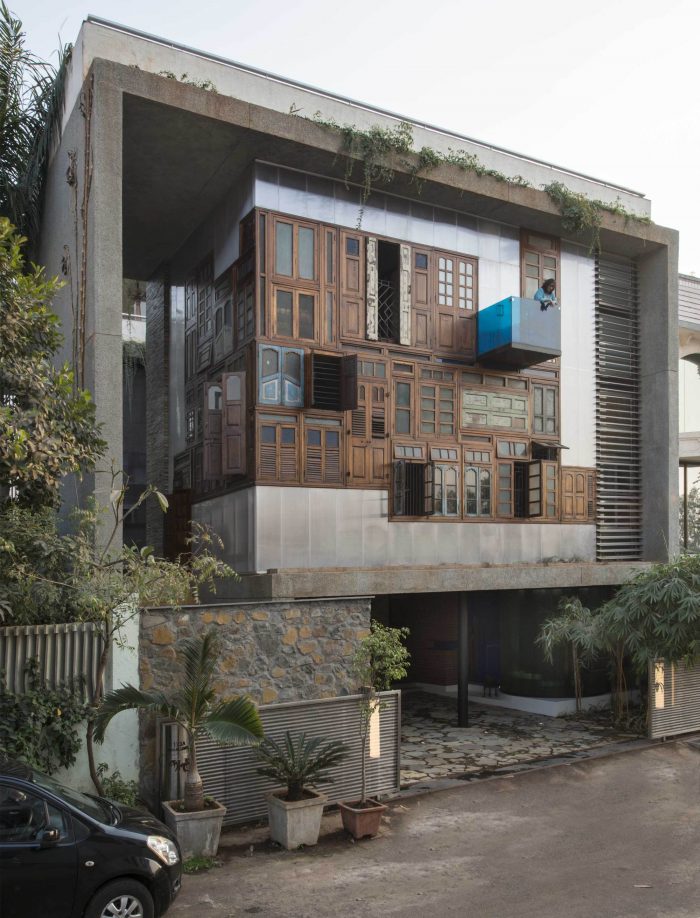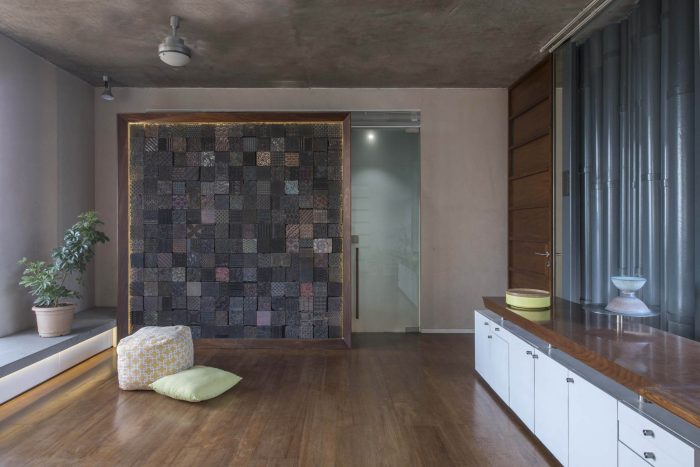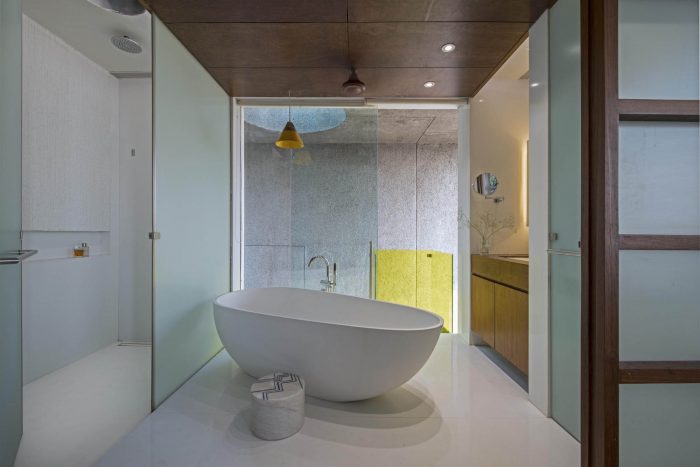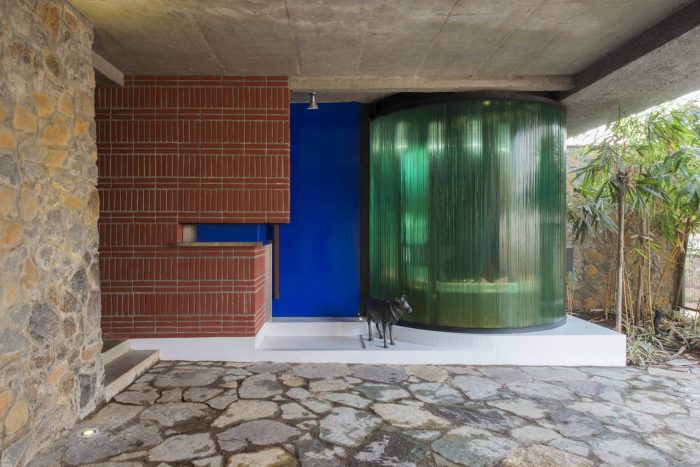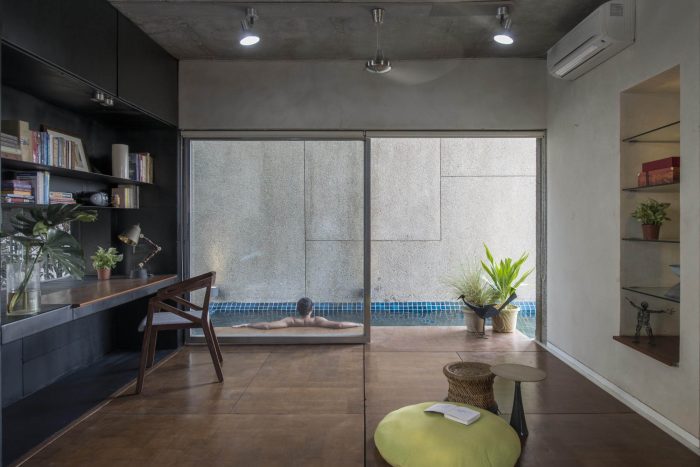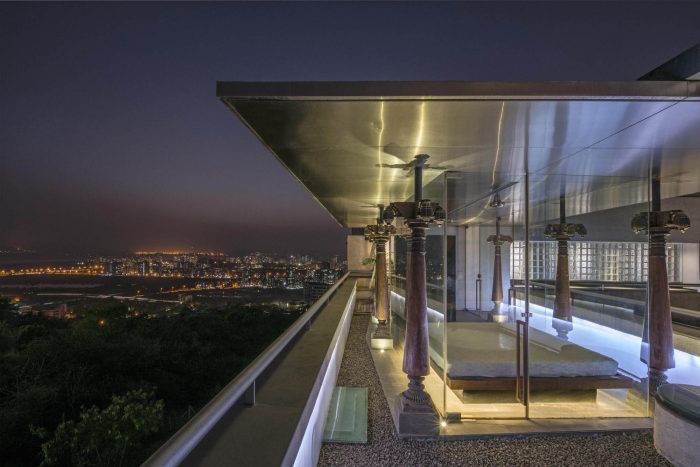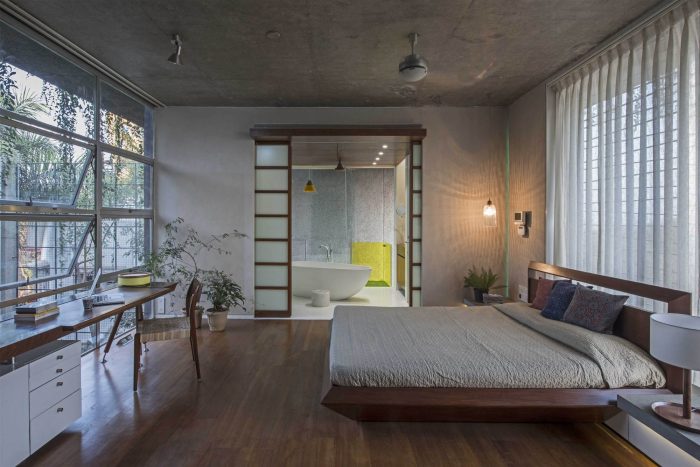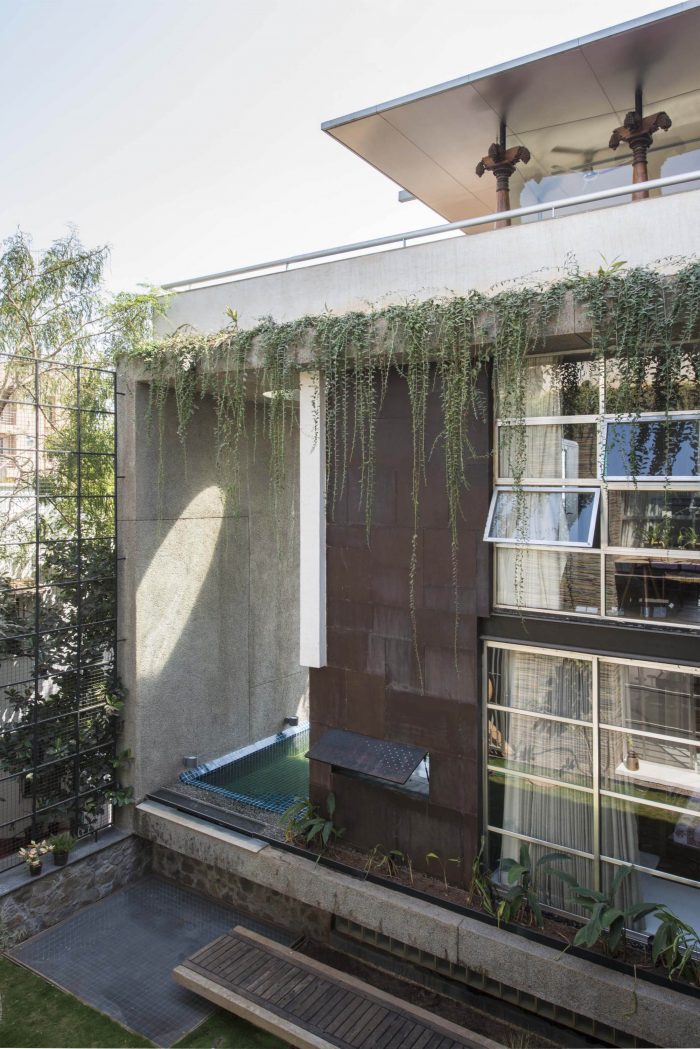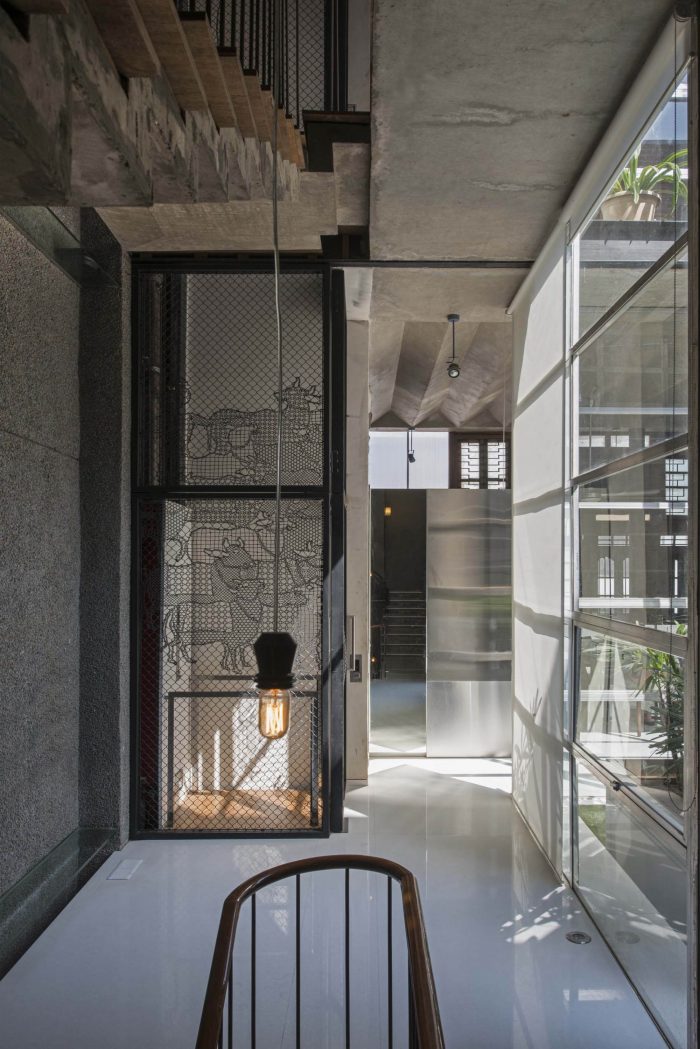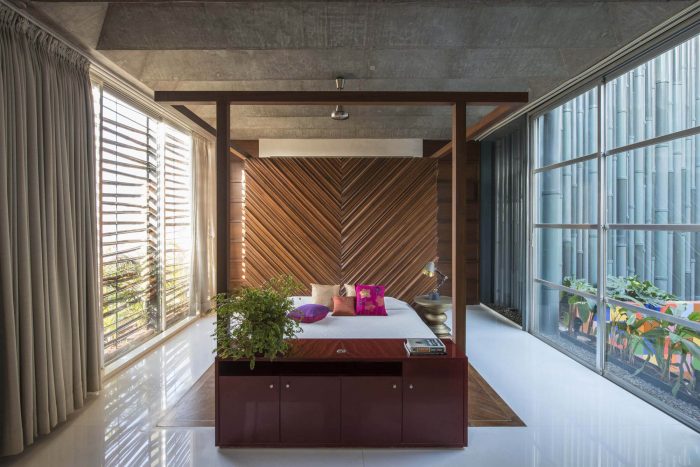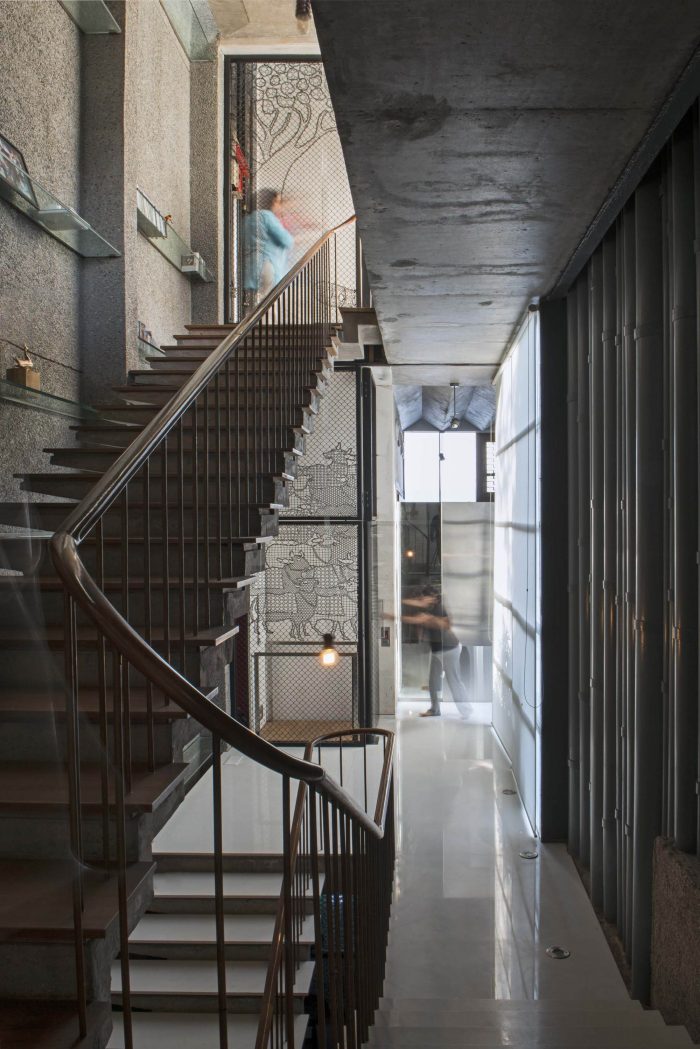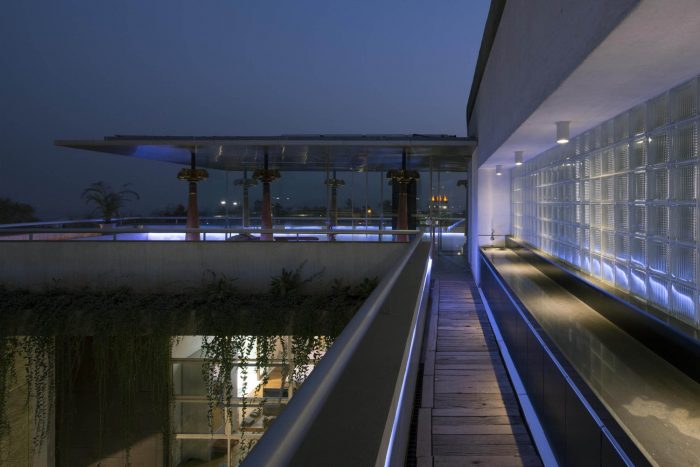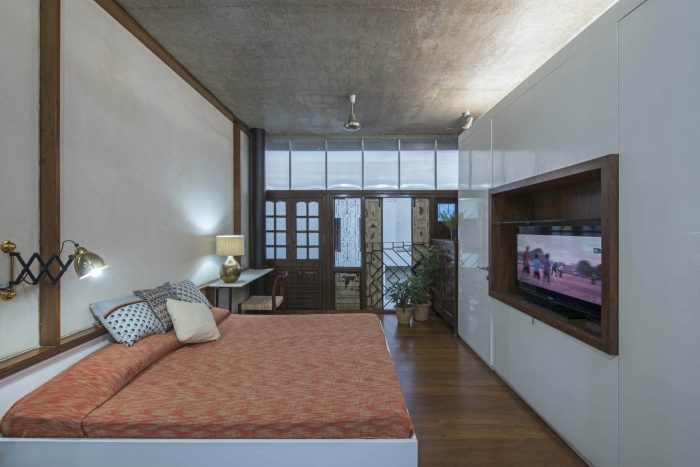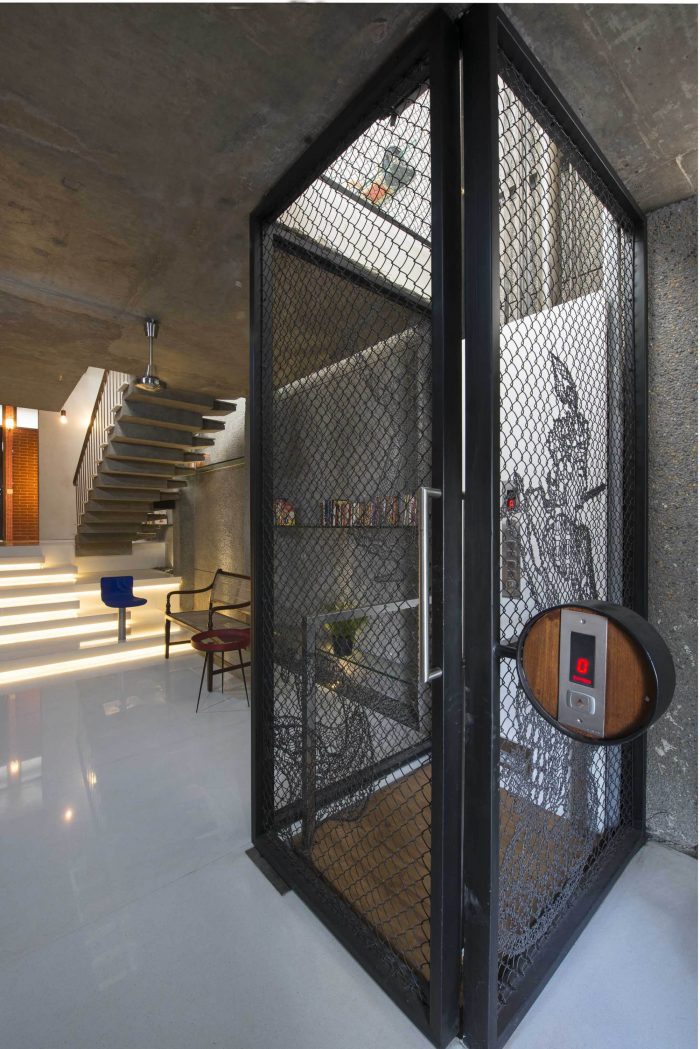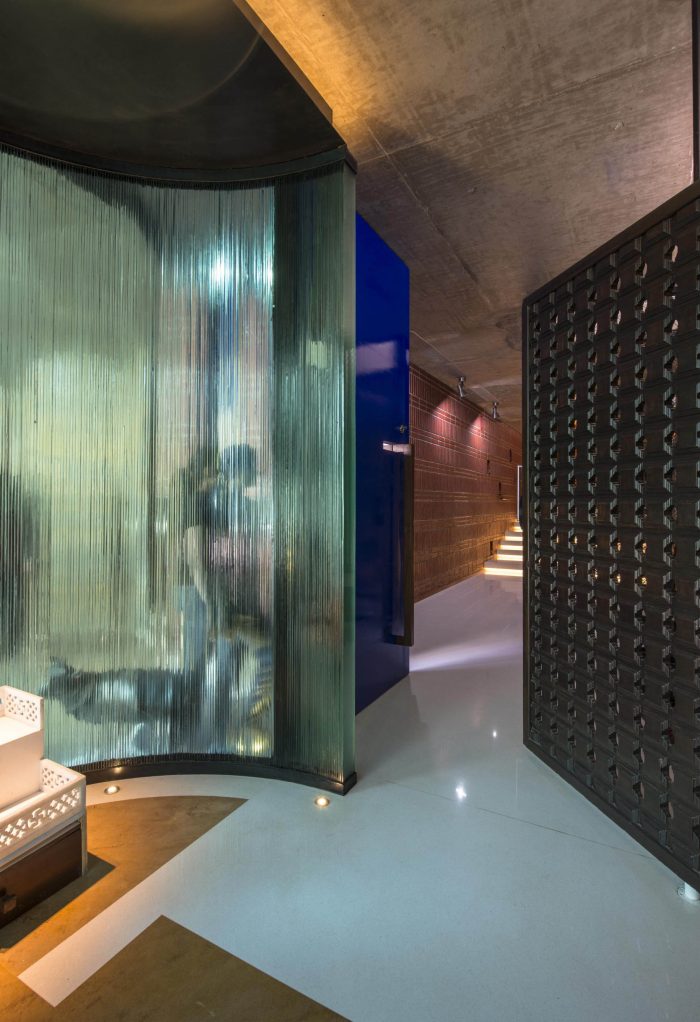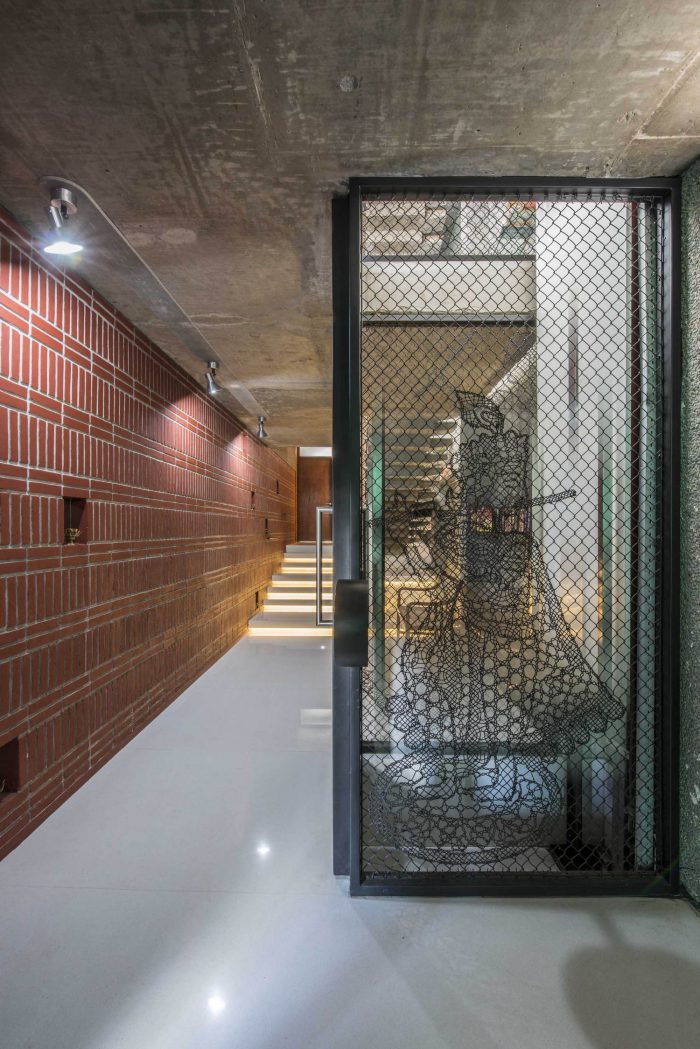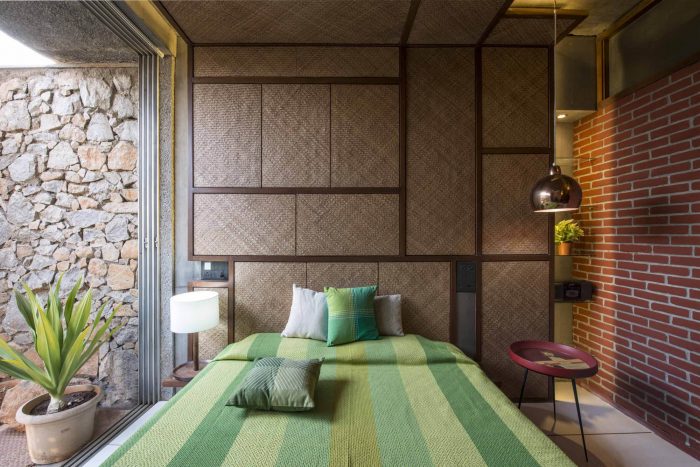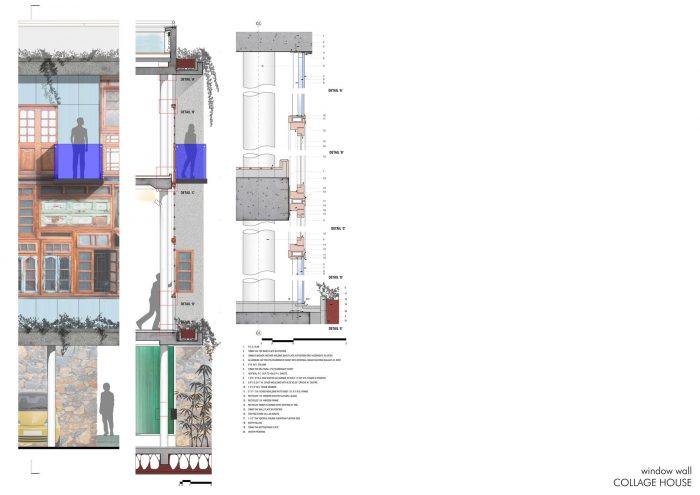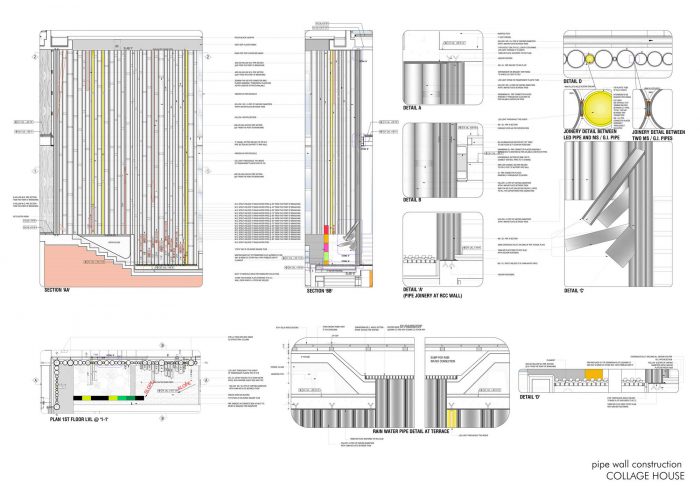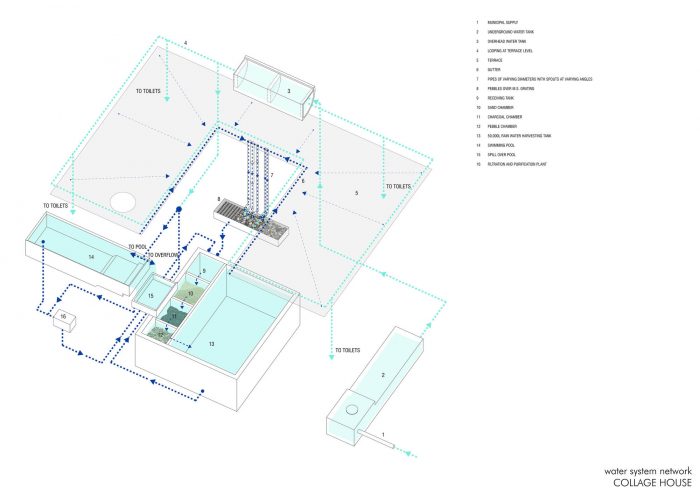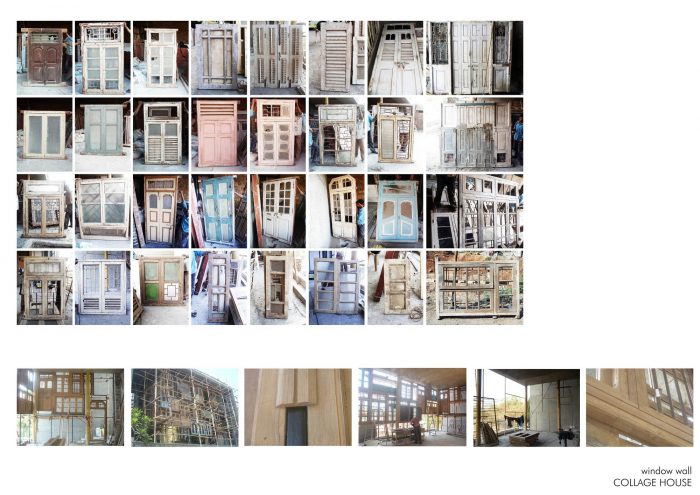生活在印度孟买,不可能忽视城市中的非正式住区,如果仔细观察,可以学到许多关于节俭、适应性、多任务、机智和独创性的经验。一种视觉语言出现了,那就是被发现的物品,临时的、折衷的、修补的和拼贴的。在这里,我们试图运用其中的一些经验,而不把它们浪漫化或迷信化。这个项目从多个方面来审视回收和拼贴的概念,从非常有形的–比如材料、能源等,到无形的–比如历史、空间和记忆。
前面的立面为里面的东西定下了基调,一个 “窗角 “回收了城市中被拆迁房屋的旧门窗。这成为客厅的主要背景,上方裸露的水泥面吊顶与地面上抛光的白色大理石与复杂的黄铜镶嵌相映成趣。像竹子一样拼接起来的金属管道余料形成了 “管道墙”,整合了结构柱、雨水下水管道和喷头雕塑,在季风中让人赏心悦目。
Living in Mumbai, India it is impossible to ignore the informal settlements in the city, and if looked at closely there are many lessons to be learnt in frugality, adaptability, multi-tasking, resourcefulness and ingenuity. A visual language emerges that is of the found object, ad-hoc, eclectic, patched and collaged. An attempt has been made here to apply some of these lessons without romanticizing or fetishizing them. The project looks at the idea of recycling and collage in several ways, from the very physical – like materials, energy, etc. to the intangible – like history, space and memories.
The front façade sets the tone for what lies within, with a “corner of windows” that recycles old windows and doors of demolished houses in the city. This becomes a major backdrop for the living room with a exposed concrete faceted ceiling above countered by the polished white marble with intricate brass inlay on the floor. Metal pipe leftovers pieced together like bamboo form a “pipe wall” integrating structural columns, rainwater downtake pipes and a sculpture of spouts that in the monsoon are a delight for all the senses.
在中央庭院的一侧,废旧生锈的金属板被铆接在一起,Kitsch色的瓷砖样品在中间保留了一个花盆,第三侧是一面用从石材切割场和现场产生的废料背面掀起的切割废料石片包覆的墙。从拆除的房屋中取出的百年老柱子唤起了人们的记忆,而在露台上的轻质钢和玻璃亭子(上面有太阳能电池板)则滋养了人们的怀旧情绪,可以俯瞰山坡下的美妙景色。这种方法在室内材料和元素中再次得到加强。它强调了新与旧、传统与现代、粗糙与成品之间的对比。你会发现使用回收的材料,如旧的纺织块,地板由旧的缅甸柚木椽子和檩条,殖民时期的家具,织物废料(chindi),以及使用传统元素和材料的新方法,如雕刻的木制模具,斜面镜子,传统的水泥砖等。
In the central courtyard on one side scrap rusted metal plates are riveted together, Kitsch colored tile samples retain a planter in the middle and on the third side is a wall clad in cut-waste stone slivers lifted off the back of stone cutting yards and waste generated on site. Hundred-year-old columns from a dismantled house bring back memories, and nostalgia is nourished with a lightweight, steel and glass pavilion (with solar panels above) on the terrace level overlooking fabulous views down the hillside. This approach is reinforced again in the interior materials and elements. It plays up this contrast between the old and the new, the traditional and the contemporary, the rough and the finished. One finds use of recycled materials like old textile blocks, Flooring out of old Burma teak rafters and purlins, colonial furniture, fabric waste (chindi) along with new ways of using traditional elements and materials like carved wooden mouldings, beveled mirrors, heritage cement tiles, etc.
一种既新奇又熟悉的语言出现了,它让我们重新思考我们身边习以为常的美学概念。为了让这种混搭更 “可接受”,它被包裹在一件 “现代性的外衣 “中(尼赫鲁)。这个混凝土框架–外面是粗糙的骨料饰面,里面是光滑的外形饰面–包裹并连接了从后到前和所有三层的所有空间。
A language emerges that is both new but strangely familiar at the same time and that makes us rethink notions of beauty that we take for granted around us. To make this mélange more “acceptable”, it is encased in a “garb of modernity” (Nehru). This concrete frame – in a rough aggregate finish outside and in a smooth form finish inside – wraps and connects all the spaces from back to front and across all three levels.
在山顶上建造总是令人兴奋的,直到建筑师发现这里四面都是邻居。这导致在设计过程的早期就向内看,围绕着典型的印度庭院进行建造,尽管略有修改。庭院实际上比地面高出一层,下面隐藏着一个用岩石包裹的大型雨水收集池,这是在挖掘过程中从山坡上移走的。它是这个四世同堂的大家庭的核心,围绕着这个核心,这个大家庭组织起来,聚集在一起。
To build on top of a hill is always exciting, until the architects discovered here that they were surrounded by neighbours on all sides. This led early on in the design process to look inwards and build around the quintessential Indian courtyard, albeit slightly modified. The court is actually raised a floor above the ground level and hidden below is a large rainwater harvesting tank wrapped with rock that was removed from the hillside during excavation. It is the core around which this large four-generation family is organized and comes together.
建筑师:S+PS Architects
占地面积:520 m²
年份:2015年
摄影: Sebastian Zachariah, Ira Gosalia, Photographix Pinkish Shah
设计团队:Pinkish Shah, Shilpa Gore-Shah, Mayank Patel, Gaurav Agarwal, Shrutika Nirgun, Divya Malu, Manali Patel, Ved Panchwagh, Priyadarshi Srivastava
利亚斯建筑事务所:Sopan Prabhu Architects
结构工程师:Rajeev Shah & Associates
服务顾问:Arkk Consultants
景观:S+PS Architects
现场监理:Amish Mistry Architect
主要土建施工单位:Homework Constructions
制造:Deepak Mhatre, Shafibhai, Imam Steel, Furkan Sheikh
骨料石膏:Arvind Rathod
窗口:Natwarlal Kawa
水暖工程:Ajay Majhi,Hussainbhai
Carpentary:Aditya Rana.
电气:Praful Sonawane, Mahesh Sawant
土木工程:Kantilal Suthar、Sawarmal、Jagdish Mulchand、Jagrut Kumar
油漆和抛光工程:Bajrangi
纹理石膏:Junaid
城市:Navi Mumbai
国家:印度
Architects: S+PS Architects
Area: 520 m²
Year: 2015
Photographs: Sebastian Zachariah, Ira Gosalia, Photographix Pinkish Shah
Design Team:Pinkish Shah, Shilpa Gore-Shah, Mayank Patel, Gaurav Agarwal, Shrutika Nirgun, Divya Malu, Manali Patel, Ved Panchwagh, Priyadarshi Srivastava
Liasion Architects:Sopan Prabhu Architects
Structural Engineers:Rajeev Shah & Associates
Services Consultants:Arkk Consultants
Landscape:S+PS Architects
Site Supervision:Amish Mistry Architect
Main Civil Contractors:Homework Constructions
Fabrication:Deepak Mhatre, Shafibhai, Imam Steel, Furkan Sheikh
Aggregate Plaster:Arvind Rathod
Windows:Natwarlal Kawa
Plumbing Works:Ajay Majhi, Hussainbhai
Carpentary:Aditya Rana
Electrical:Praful Sonawane, Mahesh Sawant
Civil Finishing Works:Kantilal Suthar, Sawarmal, Jagdish Mulchand, Jagrut Kumar
Painting& Polishing Works:Bajrangi
Textured Plasters:Junaid
City:Navi Mumbai
Country:India

